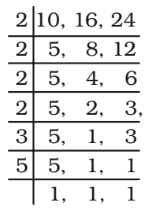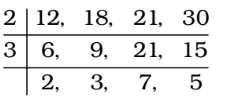LCM and HCF
- If the students of a class can be grouped exactly into 6 or 8 or 10, then the minimum number of students in the class must be
-
View Hint View Answer Discuss in Forum
If the students of a class can be grouped exactly into 6 or 8 or 10, then
Required number of students = LCM of 6, 8, 10Correct Option: B
If the students of a class can be grouped exactly into 6 or 8 or 10, then
Required number of students = LCM of 6, 8, 10 = 120
- The smallest square number divisible by 10, 16 and 24 is
-
View Hint View Answer Discuss in Forum
We find LCM of = 10, 16, 24

∴ LCM = 22 × 22 × 3 × 5
∴ Required number = 2 × 2 × 2 × 2 × 3 × 3 × 5 × 5Correct Option: D
We find LCM of = 10, 16, 24

∴ LCM = 22 × 22 × 3 × 5
∴ Required number = 2 × 2 × 2 × 2 × 3 × 3 × 5 × 5
Required number = 3600
- Which is the least number which when doubled will be exactly divisible by 12, 18, 21 and 30 ?
-
View Hint View Answer Discuss in Forum
We have , The LCM of 12, 18, 21, 30

∴ LCM = 2 × 3 × 2 × 3 × 7 × 5 = 1260Correct Option: C
We have , The LCM of 12, 18, 21, 30

∴ LCM = 2 × 3 × 2 × 3 × 7 × 5 = 1260∴ The required number = 1260 = 630 2
- Let the least number of six digits which when divided by 4, 6, 10, 15 leaves in each case same remainder 2 be N. The sum of digits in N is :
-
View Hint View Answer Discuss in Forum
LCM of 4, 6, 10, 15 = 60
Least number of 6 digits = 100000
The least number of 6 digits which is exactly divisible by 60 = 100000 + (60 – 40) = 100020
∴ Required number (N) = 100020 + 2 = 100022Correct Option: B
LCM of 4, 6, 10, 15 = 60
Least number of 6 digits = 100000
The least number of 6 digits which is exactly divisible by 60 = 100000 + (60 – 40) = 100020
∴ Required number (N) = 100020 + 2 = 100022
Hence, the sum of digits = 1 + 0 + 0 + 0 + 2 + 2 = 5
- The least number, which when divided by 4, 5 and 6 leaves remainder 1, 2 and 3 respectively, is
-
View Hint View Answer Discuss in Forum
We know that when a number is divided by a, b or c leaving remainders p, q or r respectively such that the difference between divisor and remainder in each case is same i.e., (a – p) = (b – q) = (c – r) = t (say) then that (least) number must be in the form of (k – t), where k is LCM of a, b and c .
Here t = 4 – 1 = 3, 5 – 2 = 3, 6 – 3 = 3Correct Option: A
We know that when a number is divided by a, b or c leaving remainders p, q or r respectively such that the difference between divisor and remainder in each case is same i.e., (a – p) = (b – q) = (c – r) = t (say) then that (least) number must be in the form of (k – t), where k is LCM of a, b and c .
Here t = 4 – 1 = 3, 5 – 2 = 3, 6 – 3 = 3
∴ The required number = k - t = LCM of ( 4, 5, 6 ) – 3
Hence , The required number = 60 – 3 = 57

